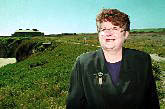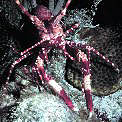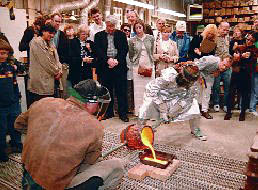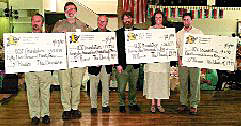 UCSC
purchases Terrace Point property UCSC
purchases Terrace Point property
UC Santa Cruz has acquired approximately 55 acres
adjacent to the campus's Joseph M. Long Marine Laboratory
and the new Seymour Marine Discovery Center. The property
was purchased from Wells Fargo Bank for $4 million.
It is expected that UCSC will permanently protect the
wetlands and some other portions of the site, possibly as a
natural reserve. Although UCSC has not developed plans for
the remainder of the site, other potential uses of the land
include development of ocean and coastal research facilities
and some complementary housing. In addition, there is
discussion of the development of a science park for children
that would augment the educational programs slated for the
Seymour center.
"This is a very positive decision for everyone," noted
Chancellor Greenwood. "UC Santa Cruz welcomes the
opportunity to enhance our existing coastal research and
teaching resources, and at the same time, we take seriously
the responsibility for careful stewardship of this unique
property. This acquisition advances our prospects for new
research partnerships."
Found at UCSC: Horoscope written
by Johannes Kepler
A400-year-old manuscript penned by one of history's
greatest astronomers was
recently discovered at UCSC.
 The
manuscript is a horoscope authored by 16th-century
astronomer Johannes Kepler sometime in the late 1500s or
early 1600s. The discovery was made by Anthony Misch, an
astronomer at Lick Observatory. The
manuscript is a horoscope authored by 16th-century
astronomer Johannes Kepler sometime in the late 1500s or
early 1600s. The discovery was made by Anthony Misch, an
astronomer at Lick Observatory.
Misch was researching solar eclipse expeditions in the
University Library archives when he discovered the
unassuming six- by eight-inch framed paper in a drawer of
miscellanea. The horoscope was annotated in German.
Misch, a book collector who speaks German, had an
immediate sense of the significance of what he held in his
hand.
"It was a pretty thrilling moment," Misch said. "I knew
right away this had potential to be a pretty spectacular
discovery. As I looked the document over my hand was
shaking."
Kepler, who lived from 1571 to 1630, is best known for
his discovery of the laws of orbital motion. He was also a
phenomenal mathematician and was responsible for major
breakthroughs in telescope optics. He is considered to be,
along with Copernicus and Galileo, among the most important
astronomers of the modern era.
$17.7 million grant for marine
research
 Aconsortium
of marine scientists from UCSC and three other major
universities has received a grant of $17.7 million from the
David and Lucile Packard Foundation to conduct ecological
research aimed at improving the conservation of marine
ecosystems. Aconsortium
of marine scientists from UCSC and three other major
universities has received a grant of $17.7 million from the
David and Lucile Packard Foundation to conduct ecological
research aimed at improving the conservation of marine
ecosystems.
The Partnership for Interdisciplinary Studies of Coastal
Oceans (PISCO) brings together four leading centers of
marine science research: UC Santa Cruz, UC Santa Barbara,
Stanford University, and Oregon State University. By
combining their strengths, PISCO will enable researchers at
these institutions to conduct coordinated studies of coastal
ecosystems on an unprecedented scale.
The grant will fund research into the interactions of
marine organisms such as rockfish (above) and rock lobster
(below). The five-year project will involve researchers from
diverse fields working toward an integrated picture of the
coastal environment and ecosystems.
A major focus of the group's efforts will be to study the
movements and interactions of fish and other marine
organisms over a 1,200-mile stretch of ocean from Oregon to
southern California, said Peter Raimondi and Mark Carr,
biology professors at UCSC and two of the project's
principal investigators. "This partnership allows us to look
at marine ecological processes at the scales at which things
really happen," Raimondi said.
UCSC psychologist to receive
field's 'Nobel'
 Anyone
who has taken an introductory psychology class or read a
best-selling self-help book has been touched by the work of
Elliot Aronson, a man whose research has fundamentally
shaped our knowledge of what motivates human behavior. Anyone
who has taken an introductory psychology class or read a
best-selling self-help book has been touched by the work of
Elliot Aronson, a man whose research has fundamentally
shaped our knowledge of what motivates human behavior.
From cognitive dissonance to the causes of interpersonal
attraction, Aronson's research has pushed the envelope,
often challenging established theories and always addressing
important social problems, including prejudice reduction,
energy conservation, and AIDS prevention.
One of the most distinguished social psychologists of our
time, Aronson, a professor emeritus of psychology at UCSC,
will receive the American Psychological Association's
1998-99
Distinguished Scientific Contribution Award at the APA's
convention in August. Considered the "Nobel Prize of
psychology," the award is the highest recognition offered to
psychologists for a lifetime of research. Previous
recipients include B. F. Skinner, Carl Rogers, Jean Piaget,
and Leon Festinger.
Aronson, 67, who came to UCSC in 1974, credits his
mentors and students with his success. "I've been very lucky
to have had some brilliant teachers and to have worked with
some terrific students along the way," said Aronson. "Social
psychology has always thrilled me because it is such a
wonderful blend of art and science. To tell you the truth, I
don't think I'm that smart--I just found the perfect thing
in the world for me. I can't imagine I would've been as
happy or productive doing anything else."
$1.5 million gift for Jewish
studies
With a gift of $1.5 million, a San Francisco Bay Area
couple has established an endowment for Jewish studies at
UCSC. The gift is the largest private donation ever received
by the Humanities Division.
The gift comes from Helen and Sanford Diller of Woodside.
Named the Helen and Sanford Diller Family Endowment in
Jewish Studies, the donation will support and expand UCSC's
interdisciplinary program, which focuses on modern Jewish
history, life, and cultures.
"We are honored that the Dillers selected UCSC as the
home for this endowment," said Chancellor Greenwood. "Their
generous gift constitutes the cornerstone of a major UCSC
effort to build Jewish studies."
The gift was made through the Jewish Community Endowment
Fund of the San Francisco Jewish Community Federation.
New policy increases UC-eligible
students
The university's board of Regents has approved changes in
freshman eligibility that will make the top 4 percent of
students from all California public high schools eligible
for UC.
UC faculty developed the new criteria following more than
a year of considering ways for the university to increase
the number of UC-eligible students in order to meet its
obligation to the state to enroll from the top 12.5 percent
of California high school graduates and continue to maintain
academic quality.
Granting eligibility to students who rank in the top 4
percent of each high school class based on UC-required
courses will make nearly 3,600 additional students eligible
for the university.
Those new students increase the percentage of high school
graduates eligible for UC from 11.1 to 12.5 percent as
required by California's Master Plan for Higher
Education.
This new path to eligibility greatly enhances UC's
ability to attract students from across the state,
particularly from rural and inner-city schools, said UC
President Richard C. Atkinson.
UCSC considered for adaptive
optics center
 Acommittee
from the National Science Foundation visited UCSC recently
to evaluate a proposal to create a national Center for
Adaptive Optics on campus. The center would coordinate the
efforts of researchers across the country working in the new
field of adaptive optics, which has major applications in
astronomy and vision science. Acommittee
from the National Science Foundation visited UCSC recently
to evaluate a proposal to create a national Center for
Adaptive Optics on campus. The center would coordinate the
efforts of researchers across the country working in the new
field of adaptive optics, which has major applications in
astronomy and vision science.
Adaptive optics is a method to actively compensate for
changing distortions that cause blurring of images.
Turbulence in the atmosphere causes blurring of images
obtained by ground-based telescopes. Similarly, internal
imperfections and small motions in the eye result in blurred
vision and interfere with efforts to study the living human
retina.
The adaptive optics system at UC's Lick Observatory uses
a laser beam (captured in the time-exposure photo above) to
measure turbulence in the atmosphere.
Chancellor urges scientists to
expand role in K-12 education
Speaking at the annual meeting of the American
Association for the Advance- ment of Science, UCSC's
chancellor urged her fellow scientists to become directly
involved in efforts to improve science education and the
public's understanding of science.
Presiding as president of AAAS, Greenwood advocated
changes throughout the educational pipeline and proposed a
national campaign to promote the involvement of
scientists
on school boards.
While recent scientific discoveries and advances give
scientists ample cause to celebrate, the United States may
be slipping behind other nations in its ability to inspire
and educate the next generation of scientists, Greenwood
said at the meeting in Anaheim this past January.
"We can already see indications that the next generation
is not receiving the preparation necessary to maintain the
excellence that U.S. science currently enjoys," Greenwood
said, pointing to the results of recent surveys that show
U.S. 12th graders near the bottom in international
comparisons of science and math ability.
Greenwood urged scientists, engineers, and other
scientifically literate professionals to get involved in
K-12 education by serving on school boards. She
proposed an AAAS program called "Project 20/20" to sustain
and support these board members with information and advice
to help them protect and enhance scientific content and
accuracy in schools.
"Education for our children, and lifelong education for
all of us, must be paramount in this evolving era,"
Greenwood said.
Celebrating the arts at
UCSC
"In these walls, future generations of Picassos,
Coppolas, Oliviers, and Beethovens will study and
learn."
 UCSC
made May 2 a day to celebrate the arts as a dedication
ceremony and open house officially inaugurated several major
new arts facilities on campus. left: Onlookers watch a
bronze-pouring demonstration by Art Department staff and
students. right: Performing at the celebration were two UCSC
groups, Taki Ñan, one of UCSC's Latin American
ensembles; and Swara Sauti, UCSC's Balinese gamelan
ensemble. UCSC
made May 2 a day to celebrate the arts as a dedication
ceremony and open house officially inaugurated several major
new arts facilities on campus. left: Onlookers watch a
bronze-pouring demonstration by Art Department staff and
students. right: Performing at the celebration were two UCSC
groups, Taki Ñan, one of UCSC's Latin American
ensembles; and Swara Sauti, UCSC's Balinese gamelan
ensemble.
When hundreds of people turned out for UCSC's Celebration
of the Arts in early May, the halls echoed with the sounds
of music, theater, and art in action. The afternoon event
featured an open house that offered performances, backstage
tours, lectures, rehearsals, concerts, and
demonstrations.
In addition, many guests attended a dedication ceremony
celebrating the completion of a number of new arts
facilities. Among those facilities are music and art
studios, a 391-seat Multimedia Theater, the Experimental
Theater, and the Music Center.
The event was initially conceived simply as a dedication
of new arts facilities, but rather than emphasizing the
walls that were raised, the day's program celebrated the
learning and creativity that have and will take place within
those walls.
 Edward
Houghton, dean of the arts at UCSC, led the decade-long push
to secure funding and space for the new facilities, but
Houghton was the first to point out that the buildings are
not the only accomplishment of the last decade. "We have
many reasons to celebrate: the completion of these
exceptional facilities during a time when funding for the
arts was shrinking, the expansion of academic programs in
the arts at UCSC, an all-time high in enrollments in the
arts at UCSC, and the emergence of tremendous collaborations
between the campus and the community. As teachers, artists,
parents, and audience members, the arts belong to all of us,
and we all have cause to celebrate this exciting time for
the arts in Santa Cruz." Edward
Houghton, dean of the arts at UCSC, led the decade-long push
to secure funding and space for the new facilities, but
Houghton was the first to point out that the buildings are
not the only accomplishment of the last decade. "We have
many reasons to celebrate: the completion of these
exceptional facilities during a time when funding for the
arts was shrinking, the expansion of academic programs in
the arts at UCSC, an all-time high in enrollments in the
arts at UCSC, and the emergence of tremendous collaborations
between the campus and the community. As teachers, artists,
parents, and audience members, the arts belong to all of us,
and we all have cause to celebrate this exciting time for
the arts in Santa Cruz."
 The
May 2 dedication ceremony featured works by film and video
students and a collaborative work by Arts Division faculty
members Nobuho Nagasawa, Sharon Daniel, and Peter Elsea.
Titled Opening, the work featured video and electronic music
components, written text, and--strung colorfully outside the
Multimedia Theater--bright red binoculars so that guests
could better read the text. Special guests at the dedication
were UCSC alumni Anne Flett-Giordano and Chuck Ranberg
(co-producers of the TV show Frasier) and Lance Linares,
executive director of the Community Foundation of Santa Cruz
County. The
May 2 dedication ceremony featured works by film and video
students and a collaborative work by Arts Division faculty
members Nobuho Nagasawa, Sharon Daniel, and Peter Elsea.
Titled Opening, the work featured video and electronic music
components, written text, and--strung colorfully outside the
Multimedia Theater--bright red binoculars so that guests
could better read the text. Special guests at the dedication
were UCSC alumni Anne Flett-Giordano and Chuck Ranberg
(co-producers of the TV show Frasier) and Lance Linares,
executive director of the Community Foundation of Santa Cruz
County.
In her comments at the dedication, Chancellor Greenwood
noted that, "In these walls, future generations of Picassos,
Coppolas, Oliviers, and Beethovens will study and learn. The
teachers of our grandchildren and great grandchildren will
begin here. Perhaps our next mayor or governor, or the CEO
of a major corporation, will gain a new way of looking at
old problems because of time spent inside the walls of the
arts at UC Santa Cruz, honing his or her creative
potential."
In Memoriam
 Angus
Taylor, third chancellor of UCSC, vice president of academic
affairs under four UC presidents, and chairman of the
universitywide Academic Council during the Free Speech
Movement, died in a Berkeley hospital in April after a brief
illness. He was 87. Angus
Taylor, third chancellor of UCSC, vice president of academic
affairs under four UC presidents, and chairman of the
universitywide Academic Council during the Free Speech
Movement, died in a Berkeley hospital in April after a brief
illness. He was 87.
Chancellor from February 1976 to July 1977, Taylor is
credited with helping build an organizational foundation
upon which the campus has grown.At his family's request,
contributions in Angus Taylor's name may be made to the UC
Santa Cruz Foundation and designated for the "Angus and
Patsy Taylor Fund," an endowment that supports the academic
activities of UCSC's Cowell College.
Sheila Hough, a lecturer emerita in social sciences, died
in April; she was 67. Hough worked at UCSC from 1966 until
her retirement in 1991 as a lecturer for the Modern Society
and Social Thought Program, a lecturer in the Stevenson Core
Course, administrative coordinator for the Stevenson core
course, and counseling psychologist.
Gurden Mooser, whose decades-long association with the
campus included 13 years as the founding head of University
Relations, died in February in his Santa Cruz home after a
lengthy illness. He was 85.
Assistant chancellor for University Relations from 1965 to
1978, Mooser helped the campus attract major gifts that
established the college system and provided private support
to many other emerging academic and administrative
programs.Mooser formed the UC Santa Cruz Foundation in 1974
and served as the foundation's first executive
secretary.
At the family's request, donations in Mooser's name may
be made to the UCSC Foundation for the Seymour Marine
Discovery Center.
Alumni class gifts generate
$230,000
 Participating
in the gift ceremony were (l-r): Michael Twombly
(Cowell '69), David Graves (Crown '74), EVC John Simpson,
Alumni Association president Steve Klein, Ronna Perelson
(Porter '79), and Dobro Goodale (Kresge '94).Angus
Taylor Participating
in the gift ceremony were (l-r): Michael Twombly
(Cowell '69), David Graves (Crown '74), EVC John Simpson,
Alumni Association president Steve Klein, Ronna Perelson
(Porter '79), and Dobro Goodale (Kresge '94).Angus
Taylor
The generosity of four classes of UCSC graduates has
generated nearly a quarter of a million dollars for the UCSC
Alumni Association Scholarship Fund and other campus
programs.
Representatives of the classes of '69, '74, '79, and '94
presented checks totaling $180,000 to Executive Vice
Chancellor John Simpson at an alumni reunion luncheon during
UCSC's Banana Slug Spring Fair in mid-April. The UCSC Alumni
Association added $50,000 in the form
of a challenge grant, producing a total of $230,000.
"I want to thank all alumni, particularly the pioneers
and the classes of 1974, 1979, and 1994, for their
remarkable support of this campus and its students," Simpson
said. "It is so wonderful that while celebrating the time
you shared as students at UCSC, you have chosen to support
today's students, who follow in your footsteps."
Some $140,000 of the gift will go to the UCSC Alumni
Association Scholarship Fund, which provides support to
students with financial need. Approximately $90,000 will
benefit other areas of the campus such as college programs
and academic divisions.
UCSC, California Academy of
Sciences formalize ties
 UCSC
and the California Academy of Sciences (CAS) have agreed to
combine strengths in pursuit of their common interests in
biological research and public education. Chancellor
Greenwood and CAS Executive Director Patrick Kociolek signed
a memorandum of understanding formalizing the ties between
the two institutions in a ceremony in April at the UCSC
Arboretum. UCSC
and the California Academy of Sciences (CAS) have agreed to
combine strengths in pursuit of their common interests in
biological research and public education. Chancellor
Greenwood and CAS Executive Director Patrick Kociolek signed
a memorandum of understanding formalizing the ties between
the two institutions in a ceremony in April at the UCSC
Arboretum.
"The California Academy of Sciences has resources and
expertise that complement those of UCSC, particularly in
areas related to the increasingly important issue of
understanding the value of biodiversity," Greenwood
said.
The extensive collections of natural history specimens at
CAS are among the world's largest and provide essential
tools for comparative studies in biodiversity. Experts in
the academy's eight scientific departments include leading
authorities (known as systematists) on the classification of
different types of organisms.
"The academy has biologists and systematists whose work
dovetails nicely with research at UCSC in biology,
chemistry, and marine science, and we hope the memorandum of
understanding will foster cooperative interactions in these
areas," Kociolek said.
Chancellor Greenwood and CAS Executive Director Patrick
Kociolek shake hands over an agreement formalizing ties
between their two institutions.
Work is also continuing on a new Fitness Center in the
East Field area of the campus. The 12,000-square-foot center
is sited immediately to the south of the existing tennis
courts. The facility will feature window-filled exercise
areas, and work is expected to be completed this coming
fall.
Construction started in fall 1997 on the Marine Discovery
Center, which the UC Santa Cruz Foundation is funding at the
Joseph M. Long Marine Laboratory. Work is expected to be
completed this coming summer on the 20,000 square feet of
aquarium and exhibit hall space, a seawater teaching
laboratory, a conference and meeting room, and office
space.
|